 |
ChessBase Reviews |
Last updated 16 July 2002

| index |
CDs, DVDs, Software Part 9
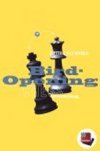
Bird Opening by Dmitrij Oleinikov
The Bird Opening is probably more popular than some people think even if it isn't seen at super Grandmaster level. The CD is well laid out and the author begins with 14 text files which form a small course on the opening. The focus lies on plans and manoeuvres, which can be applied in a variety of ways. The Russian author does not hide his liking for the White side, but also comes up with solutions for the second player, who obviously profits from knowing White’s plan.
In his research the author played around 1000 games on the internet to get a feel of how players currently played against Bird's Opening. As a result you can feel confident that you are getting sound advice on how to handle the opening. The CD contains 47 training tests, a database of 15,093 games and a variation tree and must rank amongst the best ChessBase opening disks so far. Once again I found games from our members on this CD. Here's one played by David Kilgour.
M Staples – D Kilgour [A03] BCF-ch Chester (5), 1979
1.f4 d5 2.e3 Nf6 3.b3 g6 4.Bb2 Bg7 5.Nf3 0–0
6.Be2 b6 7.0–0 Bb7 8.Qe1 c5 9.Ne5 Nc6 10.Bf3 Rc8 11.d3 d4 12.Bxc6 Bxc6 13.e4
Nd7 14.Nxc6 Rxc6 15.Nd2 e5 16.f5 Bh6 17.Rf3 Be3+ 18.Kh1 gxf5 19.Rxf5 Rf6
20.Rxf6 Qxf6 21.Nf3 Kh8 22.Bc1 Bxc1 23.Rxc1 Rg8 24.Qh4 Qxh4 25.Nxh4 Kg7 26.Rf1
Kf8 27.Nf5 Rg4 28.Kg1 Rg6 29.Rf3 Ke8 30.Rh3 Nf8 31.a4 a6 32.Kf2 b5 33.axb5
axb5 34.Rh6 Kd7 35.Rxg6 hxg6 36.Nh4 Ke6 37.g4 Nd7 38.Nf3 Nb6 39.Nd2 Nc8 40.Nf3
Nd6 41.Nh4 c4 42.bxc4 bxc4 43.Ke2 c3 44.Kf3 Nc4 45.Ng2 Na3 46.Ne1 g5 47.Ke2
Kf6 48.Kd1 Nb5 49.Nf3 Nc7 50.Ke2 Ne6 51.Ne1 Nf4+ 52.Kf3 Ke6 53.Kg3 Ng6 54.Nf3
f6 55.Ne1 Kd6 56.Nf3 Kc5 57.Ng1 Kb4 58.Nf3 Ka3 59.Ne1 Kb2 60.Kf3 Kc1 61.Ke2
Nf4+ 62.Kf1 Kd1 0–1
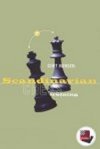
Scandinavian by Curt Hansen
I must admit I have a fondness for this opening ever since I used it as a surprise weapon to beat David Bogle in a club championship game at Hawick Chess Club.
The author of this CD has written an extensive 62 chapter openings course where he has shown some of his own secrets, but he also goes beyond the current state of theory and presents his own research. More than 30 games extensively annotated by the author (there are all in all about 500 annotated games); a real gem are his 12 games in the training mode; 316 questions are posed, and answering them you can reach a maximum number of 924 points. The text isn't extensive but good use is made of links to take you to the appropriate games. Here's one of the games on the CD from Alan Borwell.
A P Borwell - G Smith [B01] ENG-ch corr, 1967
1.e4 d5 2.exd5 Nf6 3.d4 Nxd5 4.Nf3 c6 5.c4 Nb6
6.Be2 g6 7.Bd2 Bg7 8.Bc3 0–0 9.0–0 Bg4 10.Nbd2 N8d7 11.Rc1 e5 12.dxe5 Re8
13.e6 Bxe6 14.Bxg7 Kxg7 15.Re1 Qc7 16.Ne4 c5 17.Qd6 Rac8 18.Qd2 Rcd8 19.Qc3+
f6 20.Rcd1 Bg8 21.Bf1 Re6 22.g3 Ne5 23.Rxd8 Nxf3+ 24.Qxf3 Qxd8 25.Rd1 Qe7
26.Nc3 Re5 27.b3 Be6 28.Bg2 Bc8 29.Kf1 a6 30.Qf4 g5 31.Qd2 Bf5 32.a4 Nc8 33.f4
gxf4 34.gxf4 Re6 35.Nd5 Qf7 36.Qf2 Nd6 37.Qxc5 Qh5 38.Qd4 Qxh2 39.Qf2 Ne4
40.Bxe4 Qxf2+ 41.Kxf2 Bxe4 42.a5 ½-½
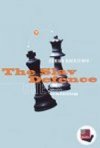
The Slav Defence by Dorian Rogozenko
Anyone planning to play, or who uses the Slav Defence as part of their Correspondence Chess repertoire must give serious consideration to buying this CD.
There are nearly 32,000 games on this CD. Thus, what is called theory, here is of an enormous size and accordingly the achievement of the author far surpasses the usual standards. After three introductory texts grandmaster Dorian Rogozenko follows up with no less than 86 database texts, which introduce the respective variations. The author scrutinized 154 games especially for this CD. Together with the Slav games regularly reviewed by Robert Hübner for the ChessBase magazine, this amounts to an enormous fund from which the user can draw. In addition, there is a tree of all games and a training database. This time I have selected a game from the CD played David Cumming.
D R Cumming - J Visser [D15] Bernard Partridge Mem-3 corr, 1995
1.d4 d5 2.c4 c6 3.Nf3 Nf6 4.Nc3 dxc4 5.e4 b5 6.e5 Nd5 7.a4
e6 8.Ng5 h6 9.Nge4 Ba6 10.Be2 b4 11.Na2 b3 12.Nac3 Nb4 13.0–0 Nc2 14.Be3 Nxa1
15.Qxa1 Qa5 16.Qc1 Nd7 17.Rd1 Bb4 18.Bh5 Nb6 19.Nc5 Bxc3 20.Nxe6 Bxb2 21.Qxb2
Nxa4 22.Qc1 g6 23.Bxg6 fxg6 24.Bxh6 Nc3 25.Re1 Na2 26.Ng7+ Kf7 27.Qf4+ Kg8
28.Rf1 Qc7 29.Nh5 gxh5 30.Qg5+ Kh7 31.Qxh5 1–0

How to play the Nimzo-Indian by Reinhold Ripperger
The Nimzo-Indian can well be called the opening of the world champions. Capablanca employed it and lost one of the most legendary games in chess history - against Botvinnik, another world champion. His successors adopted the Nimzo-Indian as well, often even with both colours. Robert Fischer scored his greatest achievements with this opening in 1972 when he - among other things thanks to a brilliant Nimzo-Indian victory - became world champion. Also his heir to the throne, Karpov, used it to good success, and after him Kasparov. Having less the character of a theoretical work, Reinhold Rippberger's CD follows a similar approach like "King 's Indian with f4" - not concentrating on concrete variations, but rather showing how to play certain types of positions. Apart from the 21 introductory texts, the heart of the CD are the 300 games with many text commentaries. Furthermore, the author presents a database with 35 games featuring training questions. On top of that, the CD contains two additional databases with more than 47,000 games. Here's one that will keep your attention for some time - an epic struggle between Phil Giulian and George Pyrich.
P Giulian - G Pyrich [E48] SCO-ch Hamilton (9), 1987
1.d4 Nf6 2.c4 e6 3.Nc3 Bb4 4.e3 0–0 5.Bd3 d5 6.Nge2 c5
7.0–0 dxc4 8.Bxc4 Nbd7 9.a3 cxd4 10.exd4 Bxc3 11.bxc3 b6 12.Bg5 Bb7 13.f3 Rc8
14.Ba2 Re8 15.Rc1 Nf8 16.c4 Ng6 17.Ng3 h6 18.Be3 Qe7 19.Qd3 Red8 20.Qb3 Rc7
21.Bb1 Nf8 22.Rfe1 Rdc8 23.Bf4 Rd7 24.Be5 Ne8 25.Kh1 f6 26.Bf4 Rxd4 27.Nf5 Qd7
28.Nxd4 Qxd4 29.Be3 Qd7 30.Red1 Qc7 31.c5 Bd5 32.Qd3 Qb7 33.cxb6 Rxc1 34.Bxc1
Qxb6 35.Be3 Qa5 36.Bd2 Qa4 37.Bc2 Qc6 38.Rc1 Qb7 39.Bb4 f5 40.Rb1 Qc7 41.Ba4
Nf6 42.Qc2 Qxc2 43.Bxc2 N8d7 44.Bb3 Nb6 45.Bxd5 Nfxd5 46.Bc5 Kf7 47.Bxb6 axb6
48.Rc1 Kf6 49.Kg1 f4 50.Kf2 g5 51.Ke2 Kf5 52.Kd3 h5 53.Rc8 g4 54.Rh8 Nf6
55.Rb8 Nd7 56.Rh8 Ne5+ 57.Ke2 Kg5 58.Rb8 Nc4 59.Kd3 Ne3 60.Rxb6 Nxg2 61.fxg4
hxg4 62.Rxe6 g3 63.hxg3 fxg3 64.Re8 Kg4 65.Ke4 Ne1 66.a4 Nc2 67.a5 Kh3 68.a6
g2 69.Rh8+ Kg3 70.a7 1–0
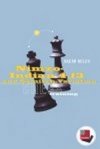
Nimzo-Indian 4.f3 and Sämisch-Variation by Vadim Milov
The Nimzo-Indian is one of Black's most popular and reliable openings. White strives for an opening advantage and interesting, rich positions with ample room for creativity. It is often a good idea to avoid the well trodden paths. Thus, the variations 4.f3 and the Sämisch, which are presented on this CD, are ideally suited to fight the Nimzo-Indian. They usually give rise to sharp, unbalanced positions with chances for both sides. In the past, players such as Botvinnik, Bronstein, Geller, Spassky have used these systems successfully, while today e.g. Shirov and Jussupow play these lines with success. On this CD grandmaster Vadim Milov presents the most important ideas and lines of this opening. Ten introductory texts with links to the most important games explain the basic ideas and variations. Numerous proposals improve today's theory while 68 games annotated by Milov offer additional information and advice. A training database invites you to test your acquired knowledge. Here's a nice win from the CD played by Joe Watson.
J Watson - Chasman [E29] corr, 1989
1.d4 Nf6 2.c4 e6 3.Nc3 Bb4 4.e3 c5 5.a3 Bxc3+ 6.bxc3 Nc6
7.Bd3 b6 8.Ne2 0–0 9.0–0 Ba6 10.Ng3 Na5 11.e4 Ne8 12.Re1 Bxc4 13.Bc2 g6 14.Bh6
Ng7 15.e5 d5 16.Qg4 f5 17.Qf4 Rf7 18.Bg5 Qd7 19.Re3 cxd4 20.cxd4 Rc8 21.Rae1
Ba6 22.Bb1 Nc4 23.Rc3 Rc7 24.h4 h5 25.Bf6 Ne8 26.Qh6 Rg7 27.Bxg7 Qxg7 28.Qg5
Rd7 29.Ne2 Nc7 30.Nf4 Kf7 31.Rg3 Nb5 32.Nxh5 Qh8 33.Qxg6+ Ke7 34.Ng7 1–0
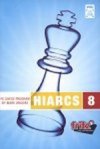
Hiarcs 8 by Mark Uniacke
My in-depth knowledge of how chess playing programs work is rather limited, so much of the information I pick up is from other sources.
HIARCS (Higher Intelligence Auto Response Chess System) is written by Mark Uniacke from England. It has been one of the world’s top programs since it won the microcomputer world chess championship in 1993.
This latest version has been improved and enhanced in a number of areas, especially in its search algorithms and the implementation of concrete chess knowledge. The maximum search depth is now up to the astonishing depth of 62 ply! The result is an increase in tactical power which produces some nice results.
The author has rewritten the pawn evaluation code and the program understands more about pawns than ever before. In ChessBase magazine Mark Uniacke wrote "I also rewrote much of the passed pawn code, which has been rewarded with a better understanding of passed pawns".
Hiarcs 8 comes with the latest Fritz7 interface where Eric Hallsworth did include a very interesting openings book and a large database of 320,000 games.
You can also download the original Hiarcs 8 tournament book by Eric Hallsworth from the ChessBase website. The broader book on the Hiarcs 8 CD was obtained by merging unselected master games with the tournament book and thus allows the program to play inferior lines. While this CD book is fine for training and fun, you should always install the pure tournament book where playing strength is the aim. Follow the instructions in the readme file. Easy to install.